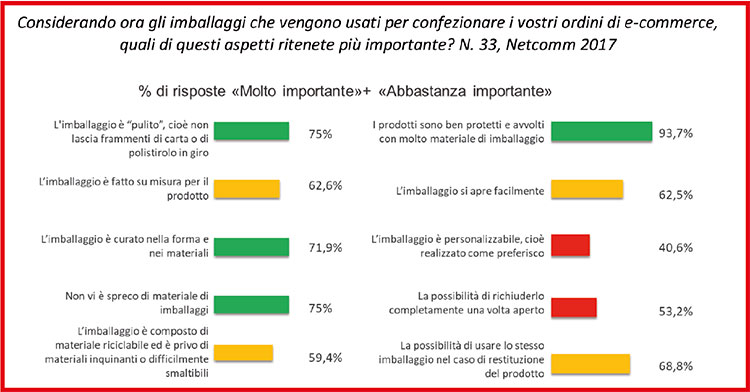Packaging for online commerce
How it grows and why: in short, the trends and scenarios from the second “Packaging & E-commerce Forum” that took place during Ipack-Ima 2018. Milena Bernardi

For over 78% of Italians who buy online, a packaging conceived with sustainable criteria helps to improve the brand reputation of a company. Source: Comieco (National Consortium for the Recovery and Recycling of Cellulose-based Packaging).
The convenience and simplicity of shopping at home has led to an exponential increase in online purchases: an escalation that has posed new challenges for those involved in packaging.
At a time when manufacturing sectors continue to shift turnover to the web, companies are forced to rethink how to package products, not only to lower transport costs, while still guaranteeing adequate protection for goods, but also to provide a positive buying experience that can be repeated in the future.
The influence exerted by e-commerce on the packaging world was therefore discussed on 31 May last at Ipack-Ima 2018, which hosted the “2nd Packaging & E-commerce Forum” and where the observatory “E-commerce and Digital in the sector of solutions and technologies for packaging” made by Netcomm and Ipack Ima was presented.
Italian percentages
Some numbers define the dimensions of the supply chain at a global level: B2C e-commerce affects 50-70% of purchase decisions and is worth 10% of global shopping, with physical assets accounting for 62% of total online sales.
Although in Italy the development of e-commerce is somewhat lagging behind compared to other countries, sales of online products in Italy are growing at a rate of 28% per year and moves 15 million deliveries every month.
In 2017 the estimated turnover was 24 billion euro, equal to 6% of total purchases. Within the sample of companies interviewed, active in the packaging technology segment, 4 out of 10 have received specific requests for e-commerce, 18.2% have already developed dedicated solutions, 13.6% have launched projects and, on top of that, 30% are considering all the opportunities.
92% of those interviewed foresee the development of specific processes and technologies for products destined for online commerce, a fact which demonstrates the high degree of involvement of the sector.
Trends and prospects
On the prevailing trends of present and future e-merchants, many ideas came from important companies such as Iper, Ferrero, GS1, Tecnobox and Just Eat, that gathered together in a round table moderated by Luca De Nardo, a journalist expert on packaging.
Volume reduction, sustainability and customization are the key words on which packaging operators are measuring themselves in this area. “Minimal” packaging that is easy to open, ie packaging solutions that minimize excess volume, saving resources and space; more sustainable, therefore, designed and optimized with a view to saving and recovering, to make disposal easier, to improve logistics management, but aboveall customized solutions, a trend that is expected to grow strongly.
The packaging, moreover, is the business card of a brand, able to convey the value of the brand to the consumer. Indeed, for more than 70% of Italian e-shoppers, the opening of the pack is the key moment of the entire purchasing process; hence, pronounced customisation becomes essential, both on the outside and on the inside of the pack, something that is crucial for generating the so-called “WOW effect” in the customer, which will influence future purchases.
Speaking of food, there is ample space for active packaging able to extend the shelf life of the product, a mode that positively impacts on both household expenditure and on the reduction of food waste.
And then there is smart packaging, which shifts the focus on interaction with the consumer and via a chip can provide detailed information on the product and its state of preservation, up to its complete traceability.
In the future e-commerce packaging could interact with the consumer by presenting data and even offers on similar products.



















